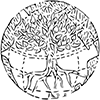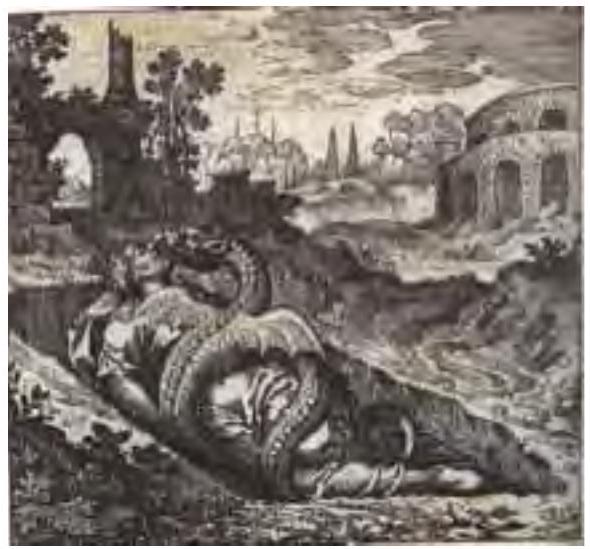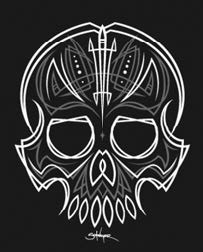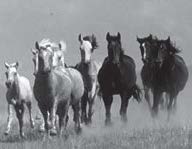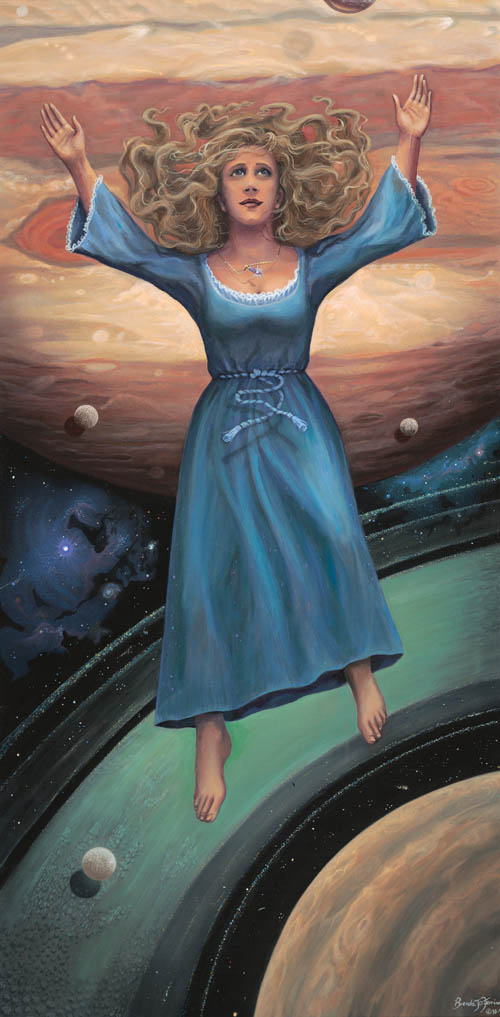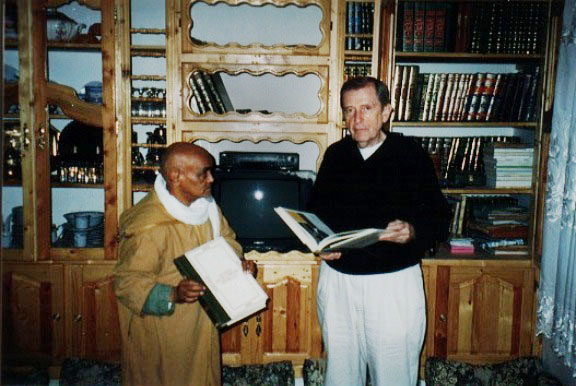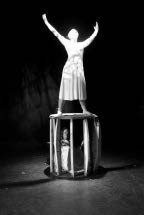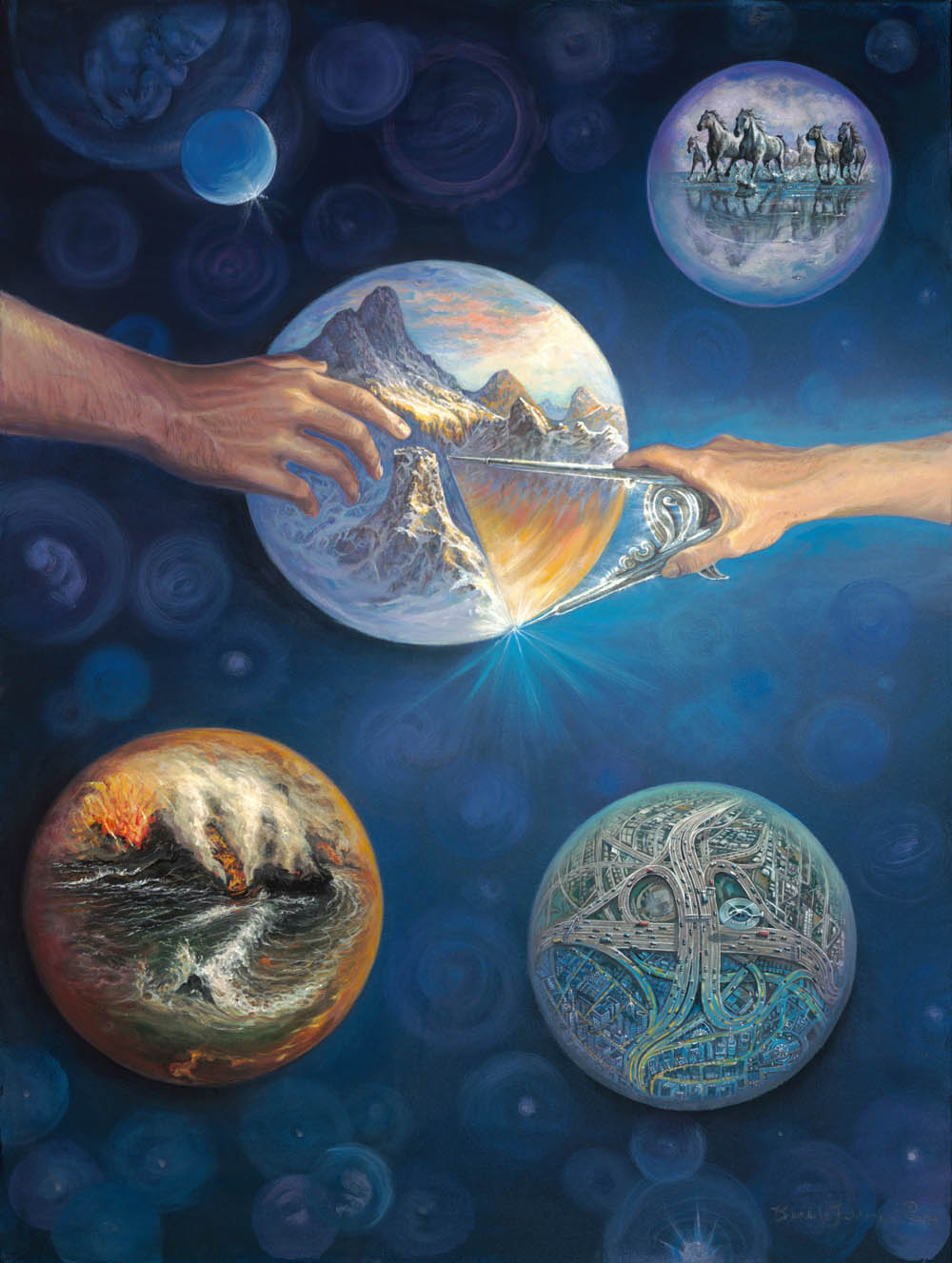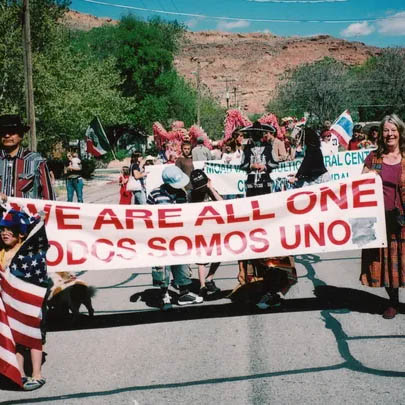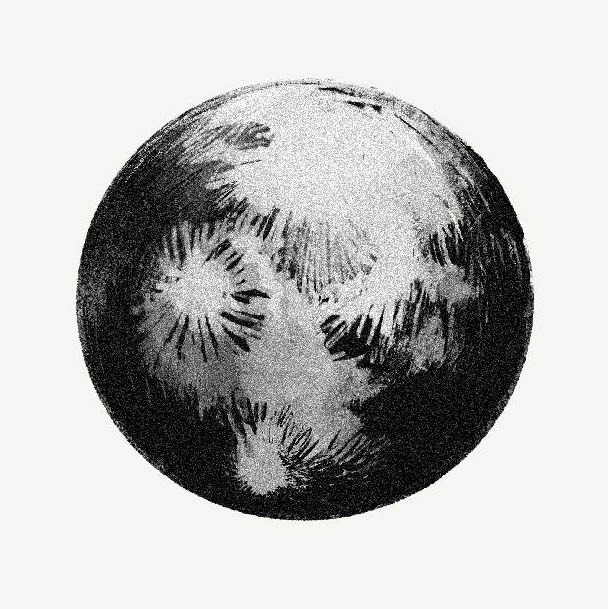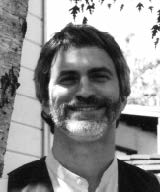
(Continued from Vol. 23 No. 1, pp. 38-43)
Abstract
(repeated) This clinical case study shows how a series of dreams guided a 3 1/2 year psychotherapy treatment. The client's dreams illustrate the intelligence of the unconscious in addressing issues of prolonged bereavement, depression, sexuality, love, creativity, and helping clarify the individual's vocation and life goals. The study demonstrates how dreams promote individuation through the emergence of a personal, spiritual symbolism. Dreams are recounted featuring the Father archetype, the Anima, figures such as The Silver Man, The Old Homeless Man, The Dead Bear, Duke Ellington, and the symbolism of archaic male initiation rites. The author notes recurring symbols through the series of dreams, and how the dreams allowed the client to work through emotionally charged memories and moods. The study illustrates in practical terms the catalytic role that dreams can play in psychotherapy.
A Dream about the Therapeutic Relationship
A few months later, Chris dreams (10/2/00):
"I was coming to therapy. I arrived at the curb and sat in the car. I heard you calling. You (Greg) were leaning out your window calling me. I'd been sitting in the car forty-five minutes listening to music. I said, 'I don't know what happened. I'm really sorry.' You said 'All right, come on up.'"
Asked his associations to this dream, Chris comments, "I'm having resistance to coming. I've been feeling like I don't have much to talk about. I'm in a dry spell." "So you are asking yourself is it worth coming here? Is it worth the money? Perhaps you're concerned that I'd be annoyed with you if you were to stop coming." "Yes, I have fear of how my decision would affect you, and of what conflicts would arise." This dream led to productive exploration of Chris' resistance to going deeper into treatment, as well as to making decisions and plans. This was also the beginning of discussions about his eventual termination of therapy-which, as Otto Rank emphasized, is a crucial horizon that makes a client aware of the urgency of making concrete life changes. All dreams about the therapeutic process are opportunities to discuss the therapeutic relationship and goals.
The Dream of the Crossroads and the Dead Bear
A few weeks later, Chris had another potent dream (10/30/00):
"I got a phone call from Liz (my girlfriend from college). She tells me she misses me. Then I am driving my truck. I take a turn off the road, going somewhere I'd been to before. I turn around in a driveway and decide to go somewhere else, taking a left turn down a road I'd always wanted to go on. I stop my truck. It is the road less traveled. It is covered with leaves. No one has been on that road for a while. It was too steep for the truck so I decided to walk it. I walk on a dirt path in the woods. I realized there was an enormous bear laying on the path. At first I thought it was sleeping. Then I realized it was dead. It had been dead for a while. I thought I should get a camera and take pictures. I walked down the path. I got spooked and headed back toward the truck. I started running as fast as I could."
When I asked Chris about Liz, the girlfriend from college, Chris noted that therapy had helped her. I said, "Maybe this is also addressing your feelings about being in therapy. Therapy can help you take control of your life, to take the road less traveled, the road that only you can go on. Taking a road that you'd always wanted to walk on is a symbol of individuation, becoming who you really are. The dream reflects fear of walking the road less traveled. To travel the road that is uniquely yours you have to deal with the Dead Bear first." Chris said that the bear was enormous. "It reminds me of my dad's death: uncontrollable nature that can't be reasoned with." I said, "So the Dead Bear could be your father; it could also represent a part of you that feels dead, defeated, giving up." This dream suggests you are approaching crossroads, life transition, big choices about what road you will travel in your life. The dream is about finding your own path, your own road."
The bear motif appears in Chris' next dream (11/27/ 00):
"I am camping out with a friend. There are rolling hills, trees. A bear and a cub come running after me, growling, snarling. The bear was right there on me. Then it stopped chasing me. Walking together, we come to the edge of some woods. There was a gate where a path started."
Camping with a friend reminded Chris of bonding, intimacy, friendship, his lack of male friends. The rolling hills remind him of a golf course; golf is a social game where guys get together. Asked about the Bear Cub, Chris says, "It reminds me of being my dad's shadow, following him around while he did his work." It reminds Chris of being a kid, a little cub. I said to Chris, "Ask the bear, why are you in my dream? What part of me do you represent?" He responded, "I'm the part of you that is your power, your spirit, the force that gives you energy and motivates you. I came to show you that you have power and that you can run in the world." "The bear is a powerful totem for you. The dream asks you to embody your bear-like qualities. A bear has a big presence, big power. The dream is telling you that you can have big power, big presence. You can grow up and become a bear, like your dad. The dream ends with finding a gate, suggesting crossing a threshold, passing through the gate. Being chased by a bear suggests an initiatory theme, comparable to mythic stories about the young hero's initiation into manhood."
A Dream of Male Initiation
Six weeks later, Chris dreams (1/8/01):
"I'm in a small rowboat, tied to a dock. A killer whale comes up from the depth, jumped up from the water, and swam underneath me. I was afraid he'd knock over the boat. I pulled the boat closer to the dock. I jumped onto the dock and ran inside a house. I was scared. Then I am in a big old Cadillac with other men. We drove along to a pier at another shore. We arrive at the pier and get out of the car. We climb down a ladder to get to a lower level of the pier. A tall man approaches me with something in his hand-a sharp stone. He was going to circumcise me with this sharp stone. I climb up the ladder. He grabs me and pulls me down. He says, 'I need to mark you.' He got me in a bear hug. He said, 'I'm going to hold you like a baby.'"
Being in the rowboat reminds Chris of drifting, having no oars. Being tied to a dock feels like being on a leash, but also suggests safety, being able to pull himself to shore. Chris said, "The whale reminds me of Jaws, a vicious predator, biting aggression. That reminds me of my relationship with Ann. We have been quite aggressive with each other lately." Apparently there was a lot of aggression swimming around underneath the seemingly calm waters. I said, "The killer whale reminds me of the story of Jonah and the whale. Joseph Campbell views this myth as a variation of the hero's journey motif, where the hero goes down into the belly of the whale. The image of the man with the sharp stone also reminds me of male initiation. It suggests that you are ready to receive the marks of manhood. This inner male initiatory figure is present and is going to mark you."
In the book Rituals of Manhood: Male Initiation in Papua New Guinea, anthropologist Gilbert Herdt (1982) discusses how the tribal societies of New Guinea feature "the ritualized development of male gender identity" through various secret rites, including graded initiations for boys from ages seven onwards (pp. 49, 53). It is believed that ritual sparks, fosters, and maintains manliness in males. Maleness, unlike femaleness, is not seen as a biological given; it must be artificially induced through secret ritual. Herdt writes, "Masculinization means the overall process of separating a boy from his mother, initiating him, ritually treating his body, biological attainment of puberty, and eventual reproductive capacity; boys must be activated by men" (p. 68). Masculinization comprises "maternal detachment, subordination, and then sexual domination" (p. 73). Boys become subordinate to men both socio-politically and sexually, through sub-incision or other physical trauma, or sexual domination by older males. Herdt calls this a "culturally sanctioned trauma," which is socially channeled, ritually reinforced, and continues to live on in a boy's sense of himself and maleness" (p. 77). Ritual utilizes "extreme aggressive behavior, to redirect the child's attachment away from the preferred maternal figure and compel it toward male figures" (p. 79). I believe that in this dream of the man with the sharp stone the archetype of male initiation is active in the unconscious, even in the absence of the father.
A Brief Reflection on the Anima Problem
Several months passed. Chris and I did several months of work focused on Ann's attraction to another man and Chris' attraction to other women. One night (June 2001) he saw a woman sing and play guitar in a nightclub, and that night he had a dream about her. He then became very moody for several days, depressed because Ann doesn't inspire him the way this woman does. I explained to Chris, "This is a problem of the anima-the enlivening feminine. When faced with the anima problem, you have three options: dump your girlfriend to pursue the inspiring woman-who probably has a boyfriend already or she is a free spirit who doesn't want to be tied down; or you can adjust to the limitations of your chosen spouse with a feeling of resignation; or you can recognize the face of the anima as your own unlived potential. In the anima problem, our soul is pierced by a longing for union. The enticing divine feminine that men long for, that we think will make us whole, carries intimations of our own wholeness. The vision of the anima often evokes a moody depression in a man, a surly resentment about the woman at home, 'the old ball and chain.' But the depression comes because you think you lack something. The anima is really a part of yourself, the creative side, an unrecognized face of your own soul." Over the next several weeks Chris began a period of artistic productivity that ended a two year drought.
A Dream of the Self under Construction
Several months later (10/22/01) Chris dreams:
"I am working construction, using a forklift to move a huge cement cinder block, six or seven feet tall. I move it three blocks away and leave it there. I come back. The route cuts through a warehouse art studio. I am dressed up in nice clothes with my wing tip shoes. Janet was in the room-an artist I worked with last year. In real life Janet is living in both NY and LA, commuting back and forth. I go back with the forklift to get another huge block." I said, "Moving the block suggests moving something that's been blocking you. The construction site suggests that the Self is under construction; building and construction suggest ego development."
Cinderblocks are used for walls, foundations. This reminds Chris of his desire for a stable foundation. Doing construction work while wearing nice clothes contrasts doing "grunt work" and building maintenance with wearing nice clothes, which Chris said represents "the intellectual and artistic part of me." I said, "The dream depicts a union of opposites. You are a man of culture and refinement driving around a forklift." Janet represents success and sophistication. She enjoys making art, she makes good money, but she lives a bohemian life in an art studio. She is a positive symbol of making it as an artist. Here again, Chris is trying to imagine himself as a viable artist in the world.
Wearing nice shoes and clothes reminds Chris of dressing up, going on job interviews, making a good impression, looking sharp, projecting an image of success. "It's an image of the enterprising artist who has motivation and drive, and is charming and successful. They say that clothes make the man." Chris is grappling with issues of persona development, not the superficial persona as a mask, but the persona of the authentic self establishing a viable place in society. The focus of the unconscious has shifted from Chris grieving his lost father to defining his own ideal: the Enterprising Artist.
The Dream of the Old Homeless Man
Next Chris dreams (10/15/01):
"I am walking though an empty house looking for people. I'm down near the Golden Gate Bridge. There are cliffs behind me, on a beach. I find an old photograph-one of my dad's. On shore, there is an old man on an inner tube. We're looking for a place to launch him off on his inner tube. He's dressed in slacks and a tweed blazer. He looks like an old homeless guy in an old, ratty suit. He gets out of the inner tube. I hug him and start crying really intensely. I didn't want him to go. I was sad he was leaving."
The inner archetypal figure of the old homeless man is re-emerging. He is the embodiment of a complex. "The Old Man reminds me of my father, grown old. This reminds me of a homeless guy I used to see around Berkeley who wears a suit. He always looked troubled. I feel tenderness for him. His troubled look reminds me of how I feel a lot, my insecurities about the world." I say, "Now it's time to launch this old guy off, and get on with your life." "Hugging the old man reminds me of not wanting to let him go, to lose him." "Like you didn't want your dad to go away." For a few moments we dwell in the grief Chris felt as he sadly watched his father's life slip away. The intense crying in the dream felt cathartic to Chris; as a little boy he bravely fought back his tears. The dream allows completion of the grieving process. Later Chris said, "The old man also represents failure to me. He's not in a nice, crisp suit. He's a derelict, not having achieved anything and not trying to. He reminds me of addiction and weakness, wanting to be an artist, but not knowing how to do it." The dream suggests Chris' need to compassionately embrace the old man, the shadow feeling of failure - not knowing how to achieve his goals. His path to wholeness requires embracing the regressive shadow, his failure complex, his feeling of defeat.
The Dream of the Maggots
A month later Chris had a dream that evoked some deep despair and negativity that occupied us for several sessions (11/12/01):
"I was in my apartment with Andy (a childhood friend). There were maggots coming out of the kitchen water tap. There was a dark trail of ants on the floor. And there were maggots in the sink. I realize I have been drinking water coming out of that tap. I woke up very disturbed."
In dreams the imagery that is most disturbing and uncomfortable usually carries the most affect. The maggots remind Chris of death and decay. "They disgust me." "What disgusts you in your life?" "What's going on in the world, terrorism, anthrax. I feel a sense of futility and hopelessness. I want to have will power and drive to overcome obstacles, but I don't have it right now. It's hard for me to focus on the future with these disturbing events." I said, "Perhaps the maggots also imply decay in the sense of not striving for clearly-defined goals, a sense of stagnation, decay, not growing." Chris said, "The maggots got on my hand and were boring under my skin, like a leech." I ask, "What's getting under your skin?" "Frustration about my career. I used to feel a sense of adventure about finding a new career. Now I feel that artists are even more irrelevant than ever. I feel fear and self-doubt." I said, "You said that the maggots remind you of leeches. What do leeches remind you of?" "Leeches remind me of taking, not giving, not sharing." "How are you being a leech?" "I'm goofing off on the job, being half-hearted, not doing much work at all." "Do you think that contributes to your feeling of decay and weakens you?" "Yes." "Drinking the water filled with maggots symbolizes this despair and discouragement. You're drinking from this tap." The maggots are a classic symbol of the alchemical mortificatio stage in the evolution of consciousness, a stage of in-tra-psychic decay and decomposition-the emergence of foul moods and deep discouragement. We descend into the dark valley before we reach the Mountain of Light.
Chris' childhood friend Andy is a successful entrepreneur who makes things happen. He again symbolizes Chris' desire to become a successful artist. "The ants are diligent workers, who can lift things five times their size." The dream depicts a contrast between the industrious worker ants and the maggots, which symbolize despair, decay, discouragement, negativity, feeling like what's the use?, rotting away on the job, not striving toward clearly-defined goals. Through this mysterious insect symbolism, the dream is attempting to bring about the union of opposites.
The Dream of the Little Girl and The Living Room
Chris' next dream (1/28/02) seemed simple but in fact had rich meaning:
"I am in a house, a living room, dimly lit; it's a beautiful, idyllic setting with dark wood, lots of plants. I'm sitting on a couch. A little girl is sitting on top of me. We're playing, giggling, talking, hanging out."
Chris comments that the dream reminds him of his sense of intimacy and love, and of Ann and the playfulness of their relationship. Many of Chris' recent dreams had featured the figure of the old man. Here, a childlike sense of wonderment of life is emphasized. The old man/senex is a symbol of what Gareth Hill (1992) calls the static masculine principle-the urge to make it, to establish ourselves in society. In the previous dream, Andy represents Hill's dynamic masculine principle, which represents ambition and drive, the puer, the emergence of potential and possibility. Chris said the dream reminds me of having a child. The child contrasts with the heavy, dark mood Chris has been in lately. Here, the unconscious gives him an image of playfulness and joy, perhaps instructing him to contact this young, feminine, playful spirit inside him. Here we see the emergence of the creative, playful spontaneity and openness of the dynamic feminine principle. But what has not so far been touched is the ground of the static feminine, which Hill describes as a source of renewal and restoration of our intrinsic wholeness.
Suddenly our work with this dream took an interesting turn. Chris said, "The room had a Japanese feel to it; it reminds me of Japanese gardens, that kind of consciousness about space and the atmosphere these gardens create. The room is lit ambiently by other rooms. It reminds me of a childhood memory: I was sitting in a dark room, the living room, while mom was in the dining room with the light on full blast. She was trying to figure out the bills, crying, hitting her head against the wall, feeling overwhelmed, as I sat in the dark room and watched her, helpless." Chris wept as he recounted this story. Here Chris connects to his experience of the static feminine: his mother's feeling of being trapped; and his own guilt about his mother's suffering, grief, her despair and hopelessness, as well as his own identification with her. It's paradoxical: The little girl in the dream living room brings him back to the boy in the dark living room watching his frantic mother's grief. The dream helps Chris understand and release his unconscious identification with his mother. This is an example of how dwelling in the atmosphere of the dream allows the unconscious to spontaneously cough up memories and feelings that need to be felt and discharged. Note how the dream links together light and darkness, joy and sorrow-another example of how dreams promote the conunctio, the creation of consciousness through the union of opposites.
The Dream of the Silver Man
Then Chris dreams (1/7/2002):
"I'm at my workplace. There is a maintenance shop in back. I look to my left and there is a metal shop. A guy is dressed in work clothes with welder's goggles. He is silver, covered with aluminum dust from head to toe. There is a big oven behind me, or a forge. I turn to my right. I see Ted (a teacher from college, head of the art department) shoulder to shoulder with me. He is so close that he pushes me off my course, nudging me. He says, 'We're all going to start complaining about a general stiffness.' He tells me that all the workers are going to start complaining about the same ailment so we can get workman's compensation."
The Silver Man reminds Chris of musician Tom Waits in a similar costume on an album cover. Chris says, "Waits is one of my heroes. He represents unbridled creativity." Here is another example of the Artist archetype that is trying to find expression within Chris' unconscious. "Silver reminds me of guys doing mime in San Francisco in silver makeup, doing performance art; doing performances for spare change; doing art for very little money, just because they love doing it." I said the oven or forge reminded me of fiery initiations, the tests that enable the youthful, dynamic masculine spirit to prove itself worthy of acceptance and validation within the static masculine social order. "The forge or oven also reminded me of the shaman or blacksmith melting solid metals to pour into molds, to shape it and forge it. Here we see the emergence of an archetypal image, the Blacksmith, the first technician of the sacred, as Eliade showed in The Forge and The Crucible (1979). The forge suggests to me alchemical themes: the fire of creativity, creation, transforming matter, the Promethean fire of art, innovation, and creativity. These fires are burning in Chris. Mime reminds Chris of silent acting-silently doing your job, going through the motions. "In the dream, the figure of Ted is influencing you, changing your direction, nudging you." "He represents ingenuity, he was an important mentor, an expert at many things in art." I ask Chris about "a general stiffness": "It reminds me of a David Mamet film about scams, people trying to pull something out of nothing." I said, "It reminds me of a creative block, a sense of inertia. A place you're stuck, in a state of negativity. Your mentor is nudging you from inside to change your course." "Ted would never complain about working hard. He'd always take pleasure in what he was doing, and he welcomed problems as something to solve." A positive male mentor figure is emerging from within, encouraging Chris to prove himself in the world by undergoing the fiery initiations that would enable him to find his place in the world.
The Dream of The Funeral and Meeting Duke Ellington
After several years of work together, Chris was on the threshold of making some major breakthroughs.
The final dream to be discussed here was intensely catalytic (2/18/02):
"I'm at a funeral in a big Cathedral, for Ellis Marsalis (father of the famous jazz musicians Branton and Wynton Marsalis). The service is over, everyone is outside, like a New Orleans street parade. The mood is somber yet celebratory. Leaving the cathedral, I am walking with Duke Ellington. I also saw Danny Glover, the actor, and wanted to meet him. The Cathedral was located on a big cliff on a Northern California coast. I walked toward the cliff. There was a chain-linked fence. I walked around it. I was feeling very emotional. I thought to myself, 'The whole world is cold, stupid, and doesn't give a damn about anything.' I was going to burst from the emotions inside me. Then I looked down and saw a patch of daffodils, colorful flowers. My emotions were released and everything made sense to me and I didn't feel overwhelmed anymore."
The funeral reminded Chris of his father, death and rebirth, celebrating life, letting go of the past, a ritual. I ask Chris about the current relevance of a ritual, and he says that he and Ann are planning their wedding. "I'm closer to where I want to be. I feel in motion, things are building momentum. With acceptance of my dad's death, I sense new possibilities for my future." The dream contains death, but then an unexpected rebirth. I ask, "What is being born?" "My ability to stand up for myself, my self-valuing."
"The Marsalises remind me of the album they made called Fathers and Sons. The album is about making art, and going through the struggle of being an artist." I added, "It seems to represent the continuity of generations and the commitment of artists-like you and your father. The New Orleans parade reminds me of Mardi Gras, a celebratory event of endings and new beginnings, a renewal of the profane world through a return to a mythic, sacred time." Deep within the unconscious there is a shift, a turning from mourning and death, to life, celebration, and creativity.
Asked about Duke Ellington, Chris says, "He is the archetypal jazz musician and artist, totally dedicated to his music. He sacrificed his life for the music." I noted, "He also represents dignity and creative genius." Chris: "He was like king of the world, carefree but somber." I noted that this image evokes the King archetype. "The name Duke denotes dignity, royalty, the solar principle where the Duke or King represents the Self. It is a symbol of individuation, of what you can become." I asked Chris if there was any further significance to meeting Duke at the funeral. Chris said, "He is there to encourage me, and inspire me to dedicate myself to being an artist and to put the work into it and to put my faith in it."
Danny Glover, Chris said, is dignified, politically active, the artist who is successful but still has principles and speaks his mind. Here again is the Artist archetype. The artists in the dream are dedicated, dignified, refined.
In the dream, Chris walks from the funeral to the cliff, suggesting uncertainty, being on the precipice. The cliff reminds Chris of the Fool, innocence, walking off the edge of the cliff, the abyss, trusting of the unconscious and the unknown.
The chain-linked fence suggests a barrier, something in Chris' way. The dream is speaking of the need to identify the internal barrier, perhaps his feeling that the world is cold and impersonal, and doesn't care about people. The dream portrays the union of opposites: suffering and happiness, despair and hope, ugliness and beauty. The counterbalance to the stupid, cold world is the flowers, the beauty of art and nature. The dream ends with a sense of closure from the funeral, the cliff, and in Chris' emotional response to the flowers. He is able to say I want to get married, I am excited about it.
This dream is an epiphany and an emotional release. It depicts an internal movement from father's death to being taken under the wing of Duke and Danny Glover, positive symbols of the male creative principle, role models to emulate, embodiments of the Artist with integrity, dedication to their craft, excellence, and achievement. Through the dream, Chris is finding the emotional nutrients he needs from within. Even though Chris' father passed away long ago, the archetypal father is there to protect and guide his development.
As I mentioned earlier, there was no funeral when Chris' father died. In the dream there is finally a funeral. This dream allowed Chris to bring closure to his long bereavement, and to put to rest his anxieties about not having a male role model to emulate. He is able to find images of his own ideal, from deep inside, from that deep core of intelligence that scripts our dreams.
Soon after this dream, Chris made a major decision about his career that would require returning to graduate school for advanced training in a specialized art technique. While many uncertainties remain about his ultimate path, he has now found his life's direction. The flow of dreams stopped for a while as Chris completed his applications to schools. He is continuing to explore with me his feelings about terminating therapy.
References
Eliade, M. (1979). The Forge and the Crucible: The Origins and Structures of Alchemy. Chicago: University of Chicago Press.
Herdt, G. (1982). "Fetish and fantasy in Sambia initiation." In G. - Herdt (Ed.), Rituals of Manhood: Male Initiation in Papua New Guinea. Berkeley, CA: University of California Press. Hill, G. (1992). Masculine and Feminine. Boston: Shambhala. Levinson, D. (1978). The Seasons of a Man's Life. New York: Ballantine.
Storr, A. (Ed.) (1983). The Essential Jung. Princeton, NJ: Princeton University Press.
